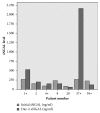Diagnostic Utility of Serum Neutrophil Gelatinase-Associated Lipocalin in Polytraumatized Patients Suffering Acute Kidney Injury: A Prospective Study
- PMID: 30533430
- PMCID: PMC6247699
- DOI: 10.1155/2018/2687584
Diagnostic Utility of Serum Neutrophil Gelatinase-Associated Lipocalin in Polytraumatized Patients Suffering Acute Kidney Injury: A Prospective Study
Abstract
Introduction: The incidence of acute kidney injury (AKI) considerably increases the mortality rate in polytrauma victims. Undoubtedly, early identification of patients at risk is crucial for timely implementation of preventive strategies in order to improve their prognosis. Therefore, we aimed to investigate if serum neutrophil gelatinase-associated lipocalin (sNGAL) may serve as a diagnostic biomarker of early AKI in polytrauma victims, especially considering patients needing renal replacement theory (RRT).
Material and methods: Forty consecutive polytrauma victims (ISS ≥ 16, AISThorax ≥ 1, age ≥ 18 years, survival time ≥ 48 hours), directly admitted to our level I trauma center within one posttraumatic hour, were enrolled in our prospective study. sNGAL-levels were assessed at admission (initial) and on day 2 after trauma. AKI was diagnosed by an increase of serum creatinine (sCr) level of at least 0.3 mg/dl within 48 hours.
Results: Out of 30 men and 10 women (mean age, 43 years; mean ISS, 29), seven patients developed AKI, four of them needing RRT. AKI was diagnosed in 86% of the affected individuals until day 2. Day2-sNGAL-levels were higher in the AKI-group, compared to the no-AKI-group (p=0.049), and in patients treated with RRT than in individuals not needing RRT (p=0.037). Noteworthy, in patients not needing RRT sNGAL-levels significantly decreased from initial to day2-measurement (p=0.040). Furthermore, at any time point during our observation period polytraumatized patients with AKI and day2-sNGAL-levels of at least 181.0 ng/mL presented with higher sCr-levels compared to polytraumatized patients without AKI and day2-sNGAL-levels lower than 181.0 ng/mL (p≤0.029).
Conclusion: In polytrauma victims suffering AKI an increase in sNGAL-level from initial to day2-assessment may signalize deterioration in kidney function and thus indicate AKI progression. Unlike initial sNGAL-levels day2-sNGAL-levels might be an appropriate tool to define AKI and to signify the need of RRT in polytraumatized patients.
Figures
Similar articles
-
Early prediction of COVID-19-associated acute kidney injury: Are serum NGAL and serum Cystatin C levels better than serum creatinine?Clin Biochem. 2022 Apr;102:1-8. doi: 10.1016/j.clinbiochem.2022.01.006. Epub 2022 Jan 31. Clin Biochem. 2022. PMID: 35093314 Free PMC article.
-
Detection of acute kidney injury in premature asphyxiated neonates by serum neutrophil gelatinase-associated lipocalin (sNGAL)--sensitivity and specificity of a potential new biomarker.Biochem Med (Zagreb). 2015 Oct 15;25(3):450-9. doi: 10.11613/BM.2015.046. eCollection 2015. Biochem Med (Zagreb). 2015. PMID: 26525750 Free PMC article. Clinical Trial.
-
Neutrophil Gelatinase-Associated Lipocalin and Contrast-Induced Acute Kidney Injury.Circ Cardiovasc Interv. 2015 Sep;8(9):e002673. doi: 10.1161/CIRCINTERVENTIONS.115.002673. Circ Cardiovasc Interv. 2015. PMID: 26333343 Clinical Trial.
-
Neutrophil gelatinase-associated lipocalin (NGAL): a promising biomarker for the early diagnosis of acute kidney injury (AKI).Acta Biomed. 2014 Dec 17;85(3):289-94. Acta Biomed. 2014. PMID: 25567470 Review.
-
Biomarker strategies to predict need for renal replacement therapy in acute kidney injury.Semin Dial. 2011 Mar-Apr;24(2):124-31. doi: 10.1111/j.1525-139X.2011.00830.x. Semin Dial. 2011. PMID: 21517976 Review.
Cited by
-
Real-Time Prediction of Acute Kidney Injury in Hospitalized Adults: Implementation and Proof of Concept.Am J Kidney Dis. 2020 Dec;76(6):806-814.e1. doi: 10.1053/j.ajkd.2020.05.003. Epub 2020 Jun 4. Am J Kidney Dis. 2020. PMID: 32505812 Free PMC article.
-
Evaluation of plasma and urine neutrophil gelatinase-associated lipocalin (NGAL) as an early diagnostic marker of acute kidney injury (AKI) in critically ill trauma patients.J Anaesthesiol Clin Pharmacol. 2023 Apr-Jun;39(2):292-301. doi: 10.4103/joacp.joacp_284_21. Epub 2023 Feb 16. J Anaesthesiol Clin Pharmacol. 2023. PMID: 37564858 Free PMC article.
-
Dysregulation of iron transport-related biomarkers in blood leukocytes is associated with poor prognosis of early trauma.Heliyon. 2024 Feb 28;10(5):e27000. doi: 10.1016/j.heliyon.2024.e27000. eCollection 2024 Mar 15. Heliyon. 2024. PMID: 38463887 Free PMC article.
-
Plasma neutrophil gelatinase-associated lipocalin as a single test rule out biomarker for acute kidney injury: A cross-sectional study in patients admitted to the emergency department.PLoS One. 2025 Jan 10;20(1):e0316897. doi: 10.1371/journal.pone.0316897. eCollection 2025. PLoS One. 2025. PMID: 39792804 Free PMC article.
-
Early prediction of COVID-19-associated acute kidney injury: Are serum NGAL and serum Cystatin C levels better than serum creatinine?Clin Biochem. 2022 Apr;102:1-8. doi: 10.1016/j.clinbiochem.2022.01.006. Epub 2022 Jan 31. Clin Biochem. 2022. PMID: 35093314 Free PMC article.
References
-
- Bellomo R., Ronco C., Kellum J. A., Mehta R. L., Palevsky P. Acute renal failure—definition, outcome measures, animal models, fluid therapy and information technology needs: the Second International Consensus Conference of the Acute Dialysis Quality Initiative (ADQI) Group. Critical Care. 2004;8(4):R204–R212. doi: 10.1186/cc2872. - DOI - PMC - PubMed
-
- Rahman M., Shad F., Smith MC. Acute kidney injury: a guide to diagnosis and management. American Family Physician. 2012;86(7):631–639. - PubMed
Publication types
MeSH terms
Substances
LinkOut - more resources
Full Text Sources
Miscellaneous


